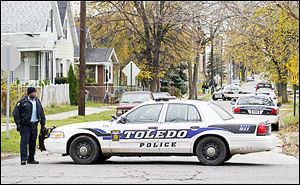
COMMENTARY
Detroit’s problems are also Toledo’s
1/13/2013
Toledo police block a street following a report of two people shot, an occurrence that mirrors Detroit.
I spent New Year’s Eve with friends on Detroit’s east side. Ten minutes before midnight, someone turned the music down. We got ready to listen to an annual Detroit tradition: A fusillade of celebratory gunfire to ring in the New Year. Gunshots were already popping off, growing to a crescendo that sounded like a war zone.
“At least you’ll be getting away from all this,’’ said a guy filling my glass who knew I was moving to Toledo.
I suddenly felt like a stranger. Losing my Detroit tag hurts. Like most Detroiters, I have a fierce and stubborn loyalty to the D. Despite the problems — maybe even because of them — I still consider Detroit the greatest city in the country.
“Hey, man,” I said, almost defensively. “Toledo has issues too.”
I’ve lived in Detroit for 15 years, writing, up to recently, about that beautiful, miraculous, and terrifying place for the Detroit Free Press — 10 years as a columnist and editorial writer and five years as a reporter. Last October, I became deputy editorial page editor of The Blade. I move to Toledo on Feb. 1.
As a newbie and commuter, I don’t know much about Toledo. But I’ve seen enough to know that Toledo — and every other urban area in the country — faces the same issues and problems as Detroit. The difference is one of size and scale. For anyone living in the Toledo area, Detroit’s struggles should provide a cautionary tale and wakeup call.
Like most larger cities, Toledo has neighborhoods, or pockets, of concentrated poverty. In Detroit, the hood covers most of the city. Instead of pockets of poverty, the D has pockets of relative prosperity — neighborhoods such as Indian Village, East English Village, Rosedale Park, and Boston-Edison. Even some of those spots now are laced with abandoned buildings and blight.
Downtown Detroit, where I live, has come back with boutiques, clubs, coffee shops, restaurants, and condo developments, but progress there has yet to touch the neighborhoods.
City government is effectively broke. You can drive for blocks without seeing a working street light. Buses are unreliable. Response times for 911 calls are a joke.
With fewer than 750,000 people, Detroit may be continuing to lose as many as 15,000 people a year. Except for the debris, many blocks on the east side are so depopulated they resemble the countryside. No doubt, Toledo, with less than half of Detroit’s population, is also bleeding — maybe 1,500 people a year — but at a slower rate.
Detroit’s half-century of decline has exacted enormous human costs. Some of the city’s disfranchised and disconnected young men, growing up on impoverished, hard-knock blocks, see little way out.
My brother-in-law, who’s now 40, told me that, in the Detroit east-side neighborhood that he grew up in, every one of his peers went to prison or jail.
In Toledo, I haven’t seen block after block of vacant, boarded-up, and burned-out buildings, as I have in Detroit, a city that has lost far more than half of its 2 million people since 1950. But I do see plenty of vacant and abandoned buildings here.
In Toledo, I don’t hear about murders every day, as I do in Detroit, which reported nearly 400 homicides last year. But I do hear and read about shootings nearly every day and almost 40 killings in the city last year.
And I don’t see an 8 Mile Road in Toledo that has, historically, served as a virtual wall between Detroit and its suburbs. But I do feel real tensions between Toledo and its suburbs that undermine the region’s progress.
For decades, Detroit blew any chance for federal assistance to build a light-rail line because southeast Michigan couldn’t cooperate or develop a regional transit authority. (The region finally got it done late last year.) Dozens of communities in suburban Detroit have opted out of the regional bus system, which carries thousands of African-American workers to suburban employers.
Sound familiar? It should. On my first day at The Blade, I heard about Perrysburg’s efforts to leave Toledo’s regional bus system.
Here we go again, I thought.
In Toledo and Detroit, urban regions rise or sink together. The problems of the central city will become those of the suburbs — in fact, they already have. Today’s economies are regional at their smallest. The urban areas that do best are the regions that manage to work together.
Still, I’ve always been an optimist about Detroit, and I suspect I’ll be one here. No doubt, Detroit’s a tough place — and proud of it. But it’s home to some of the most warm, friendly, deep, creative, smart, stylish, and resilient people on the planet. It’s an exciting time in the D. The birthplace of the auto industry and techno music, the city is drawing on its rich history and building something wondrous.
As I’ve visited places such as the Frederick Douglass Community Center in central Toledo, I’ve felt some of that same spirit, energy, and resilience.
The difference between Detroit and Toledo is that the issues and problems — struggling schools, poverty, blight, violence, regional mass transit, economic development — are still small enough to manage. In Toledo, schools still educate most kids, city government is solvent, blight is contained, population is relatively stable, more people have living-wage jobs than live in poverty. The city and region still have the resources to make a difference now — if they work together.
Toledo can decide what it is and what it wants to be — before its problems become as crushing as Detroit’s.
Take it from a new neighbor from the D, it’s a precious opportunity. Don’t blow it.
Jeff Gerritt is deputy editorial page editor of The Blade.
Contact him at: jgerritt@theblade.com or 419-724-6467. Follow him on twitter@jeffgerritt.